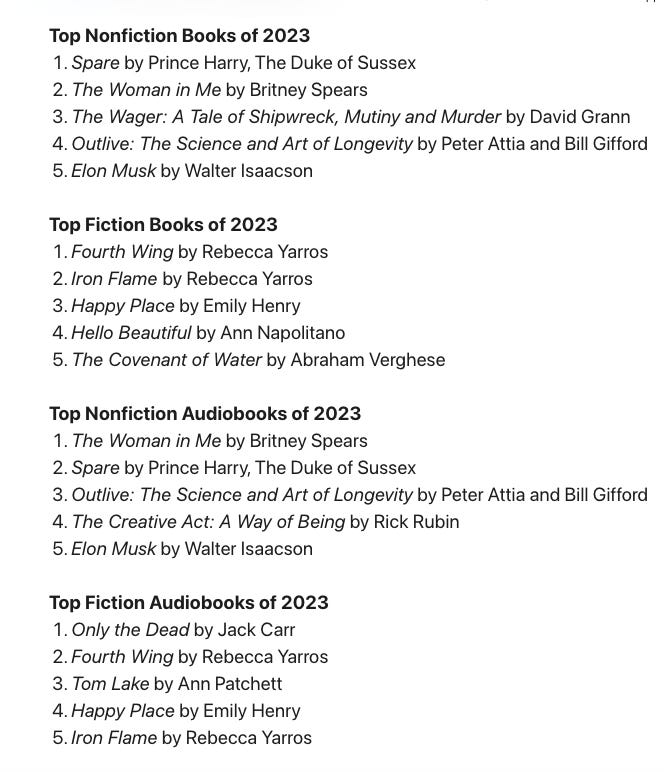The List Serves...
The best-books-of-the-year lists & a comedic detour: potential lead titles in search of an author
If you’re in the Los Angeles area on Sunday, December 10, please join Gemini Wahhaj and me at 5 PM at Village Well Books & Coffee in Culver City (9900 Culver Blvd). We’ll be discussing Gemini’s excellent debut novel, The Children of This Madness.
Monthly and annual subscriptions to Bookish are 15% off through November 30 - today! A preview of the most recent list of agents currently accepting queries can be accessed here. 📗
Numerous authors who have published new books in a given year await with anxiety and anticipation the many best-books-of-the-year lists released by newspapers and publishing-adjacent concerns. The rankings season ostensibly begins in September with the announcement of the National Book Awards’ long list.
The most well known best-books list published by a mainstream periodical is probably the New York Times’ “100 Best Books of the Year,” which this week was whittled down to “The 10 Best Books of the Year.”
In 2015, Rachel Cusk’s novel Outline, the first title in what became known as the Outline trilogy, was chosen as one of the NYT’s 10 best books, a nod that spurred me to read it. After this introduction to her work, I was transformed Fly-like into a Cusk-book-devouring creature and promptly lunged for her other books.
If you’re also a fan, you know that Cusk’s earlier novels are much different from those she’s published in the last eight or nine years, the most recent of which is the wry and weirdly hypnotic Second Place. As for her earlier novels, my favorite is the very funny The Country Life, published in the late 1990s. Her nonfiction is more consistent in its tone and style. Her first work of nonfiction, A Life’s Work, is the best book I’ve read on motherhood—not that I’ve read many books on this topic, but this one made a deep impression.
As is likely obvious from this lengthy Cusk tangent, best-of-the-year lists can have significant effects on an author’s discoverability and on a reader’s tastes and future preferences.
You’ll likely notice that the NYT’s list is literary-leaning, whereas Apple’s (see below) is comprised mostly of popular/commercial fiction and nonfiction.
Independent and small press books are increasingly left off these media rainmakers’ lists. Most small and indie presses have very limited reach, due in part to Ingram having a near-monopoly on book distribution and their MO of favoring corporate press books, which sell in greater numbers (a chicken-and-egg situation—big presses can afford to print many thousands of copies and advertise more widely than small presses, i.e. of course Ingram will favor them).
Anyway, enough about that for now. A detour: I wrote a spoof recently of a Big 5 publishing house’s marketing meeting. In order to increase the press’s bottom line, its marketing team has brainstormed and offered suggestions for future titles to its publisher/editor in chief:
Pitches for Potential Lead Titles in Search of an Author
The Bun Also Rises: Perfecting the Art of the Cinnamon Roll
The I Bling: Unlocking the Secrets to a Life of Affluence
Are You There, Tod? It’s Me, Margaret. Again. Yes, Sorry. Tod? Hello?
The Seven Hoagies of Highly Effective Sandwich Makers
A Slight in the Attic: How to Avoid Squabbles Over Family Keepsakes and Save Your Marriage

Recommendation:
Welcome to new Substacker, Sarah Tomlinson, novelist (The Last Days of the Midnight Ramblers—out in February from Flatiron Books) and former music critic at The Boston Globe—check out her Duchess of Rock newsletter!



Those titles! I so needed that laugh this morning (and currently living through "A Slight in the Attic") so thank you!
Cusk’s The Country Life is one of my favorite novels. Such a tour de force of neurotic narrative voice. I often use it as an example when teaching. So glad to see it mentioned here!